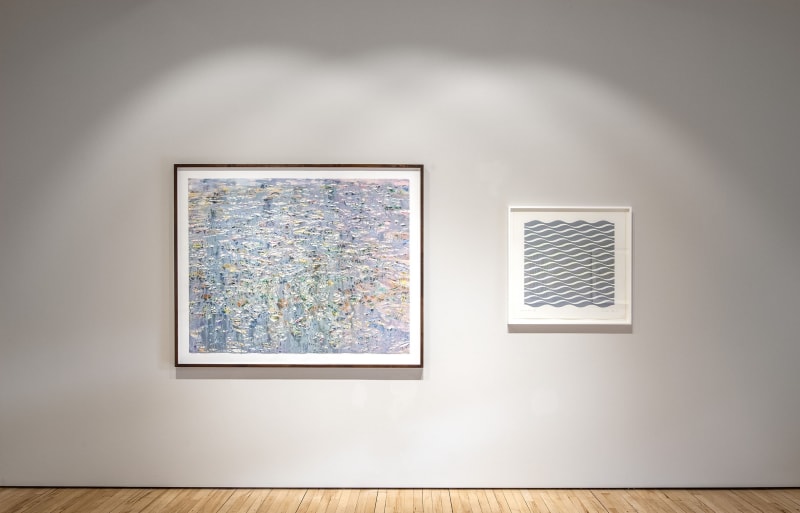For the inaugural exhibition of its 2023 programme Frestonian Gallery is delighted to present an exhibition of works on paper by Bridget Riley and Luke Elwes. This exhibition is a continuation & development of the exhibition of the same name at the Myung-Won Folk House Museum in Seoul, South Korea, which ran from October to November in 2022, and which juxtaposed Elwes’ and Riley’s work with sculpture by Korean artist Vakki and digital art by Canadian-Korean artist Sammy Lee.
The Myung-Won exhibition, curated by Stephanie Kim and Kate Lee, saw a cross-section of Riley’s works on paper in gouache and print spanning from 1966-2020 shown opposite and alongside a contemporary selection of works from Elwes’ ongoing ‘Landermere’ series – a body of work that has itself spanned some 15 years – an extraordinary exploration into the qualities of light and atmosphere in a single place (Landermere Wharf in Essex) redolent of Monet’s engagement with the landscape at Giverny in the late 19th and early 20th Century.
Riley and Elwes were, and are, both heavily influenced by the deconstructive & colour-theory elements of the 19th & 20th Century European Impressionist tradition, whilst having each developed entirely distinct modern / post-modern practices. In keeping with their forebears refined methodologies, their works each follow self-imposed restrictions of expression, yet find infinite variation within them. Riley’s early influence by the Impressionists and Pointillists – in particular Georges Seurat and Paul Cézanne – is reflected in her approach to reconstructing and reimagining the natural world in planes of pure colour and line. Her hard-edge form of abstraction is in many ways the opposite to Elwes’ more flowing, expressive and organic painting practice. Just as Riley eliminates all possible chance in the realisation of the final work, Elwes revels in it – allowing the very water that he is depicting to act as a medium in itself and shape the final expression of his densely layered and evocative works.
Works such as Riley’s ‘Coloured Greys 2 & 3’ (1972), ‘Dominance Red, Green and Blue’ (1977) and ‘Places for Change’ (2009) each freeze in a single crisp moment the wave form, whilst the optical effect of the closely aligned linear planes of colour give the sensation of movement across the surface of the off-white paper grounds. Whereas Riley’s works give us lateral momentum, Elwes’ works provide dimensional depth – drawing the viewer into considering each square foot, indeed each square inch of the work with increasing scrutiny as the various layers of gouache, crayon, pigment and ink reveal themselves in turn. In the work of Elwes and Riley we are thus asked to consider again and again what constitutes a form, a movement and, ultimately, the nature of ‘landscape’ itself.


